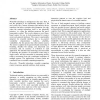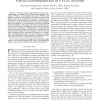966 search results - page 32 / 194 » Accuracy measures for evaluating computer pointing devices |
AUIC
2006
IEEE
14 years 2 months ago
2006
IEEE
Wearable technology is omnipresent to the user. Thus, it has the potential to be significantly disruptive to the user’s daily life. Context awareness and intuitive device interf...
MOBISYS
2008
ACM
14 years 8 months ago
2008
ACM
Personal mobile devices are increasingly equipped with the capability to sense the physical world (through cameras, microphones, and accelerometers, for example) and the network w...
ISMAR
2006
IEEE
14 years 2 months ago
2006
IEEE
We describe and evaluate a new tracking concept for outdoor Augmented Reality. A few mobile beacons added to the environment correct errors in head-worn inertial and GPS sensors. ...
SECON
2010
IEEE
13 years 6 months ago
2010
IEEE
We introduce iPoint, a passive device that can interact and deliver information to virtually any mobile phone equipped with a WiFi network interface and a camera. The iPoint does n...
TIM
2010
13 years 3 months ago
2010
Abstract--The most popular representative devices of reconfigurable computing are the Field Programmable Gate Arrays (FPGAs). A promising feature of an FPGA is the ability to reuse...


